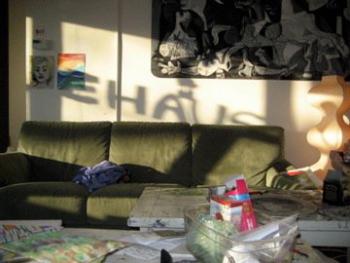Serendip is an independent site partnering with faculty at multiple colleges and universities around the world. Happy exploring!
EcoLit 313

Welcome to the on-line conversation for Ecological Imaginings, an English, Environmental Studies and Gender and Sexuality course @ Bryn Mawr College in which we are re-thinking the evolving nature of representation, with a focus on language as a link between natural and cultural ecosystems.
This is an interestingly different kind of place for writing, and may take some getting used to. The first thing to keep in mind is that it's not a site for "formal writing" or "finished thoughts." It's a place for thoughts-in-progress, for what you're thinking (whether you know it or not) on your way to what you think next. Imagine that you're just talking to some people you've met. This is a "conversation" place, a place to find out what you're thinking yourself, and what other people are thinking. The idea here is that your "thoughts in progress" can help others with their thinking, and theirs can help you with yours.
Who are you writing for? Primarily for yourself, and for others in our course. But also for the world. This is a "public" forum, so people anywhere on the web might look in. You're writing for yourself, for others in the class, AND for others you might or might not know. So, your thoughts in progress can contribute to the thoughts in progress of LOTS of people. The web is giving increasing reality to the idea that there can actually evolve a world community, and you're part of helping to bring that about. We're glad to have you along, and hope you come to both enjoy and value our shared explorations. Feel free to comment on any post below, or to POST YOUR THOUGHTS HERE.

Rhoads Pond-Site Selected
I was part of a group that transected Bryn Mawr's campus last semester with a small group of students and teachers. At the end of our walk around the perimeters of campus, we stopped in front of the site I am choosing to re-visit throughout this semester. We stopped by Rhoads Pond and were allowed to sit wherever we liked, either on top of the hill or right next to the fence. I chose a cherry blossom tree right in front of the pond and fence. It was in full bloom at the time, and I was able to appre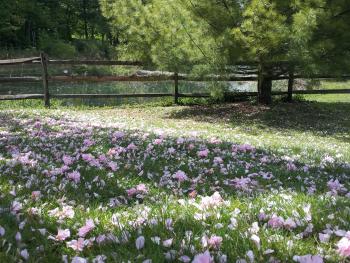
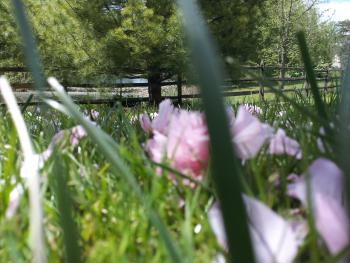 ciate the surroundings and these helped to boost my writing. I will specifically take time to sit under the tree and look out at the view of the pond. The background of the place is made up of tall trees at the other end of the pond, and the boundaries include the fence. There are some tall grasses and weeds at the borders and in front of the lake. Sometimes, these may block the view of the actual water, and this is where "terra incognita" as a concept comes in. I cannot fully see the lake, some of it is obscure from where I am sitting, so it is unknown to me unless I decide to climb the fence and dip my feet into the water. Which might take away from the neutral observation part of the project. This image is one I took at the end of our group trek around campus.
ciate the surroundings and these helped to boost my writing. I will specifically take time to sit under the tree and look out at the view of the pond. The background of the place is made up of tall trees at the other end of the pond, and the boundaries include the fence. There are some tall grasses and weeds at the borders and in front of the lake. Sometimes, these may block the view of the actual water, and this is where "terra incognita" as a concept comes in. I cannot fully see the lake, some of it is obscure from where I am sitting, so it is unknown to me unless I decide to climb the fence and dip my feet into the water. Which might take away from the neutral observation part of the project. This image is one I took at the end of our group trek around campus.

The Borders of Pangea
Solnit speaks a lot of the border between being lost and knowing where you are. She references Ptolemy's notion of Terra Incognita, which entailed the possibility that the Earth went well beyond established boundaries and an all-encompassing ocean. This made me think of Pangea, a state in which all land was connected, with no divides between the continents. I wanted to enact this with select Bryn mawr buildings, and see what it would look like if several of the dorms were so near to eachother they were practically inseperable. By doing this, I discovered that this created several small spaces were created between the dorms, which fade into the foreground while the large buildings stand out. Additionally, what went beyond the exterior of this new layout seems to fall away into gray space. I wonder what would be the effect on our campus if it was actually situated like this.

Climb lots of mountains
The image I selected is from the Sound of Music – it’s that moment when Maria is bounding into a field, arms spread, singing, feeling completely free… right before she realizes that she’s super-late for something back at the convent and sprints off back down the hill (goddamn bell!)

Forground/Background based on this image: I chose this picture because, for me, it represents emotional highs and lows based on location. In the background, there’s the unseen convent – a place related of worry, awareness of responsibilities, commitments, etc. But in the foreground, there is a sense of freedom, carelessness, and anticipation – perhaps Maria has been planning to go for this walk, looking forward to it, much like I look forward to my sources of freedom on campus. And of course, there is the challenge of the climb, which I think is a good symbol for life at Bryn Mawr.
I’m trying to accentuate the positive right now, let that positivity foreground my vision of Bryn Mawr (and I think visiting my on-campus site, the area around Arnecliffe Art Studio, will be a space of freedom). But honestly, sometimes it feels like a convent, so many tight corners and obligations.
West Philadelphia, Born and Raised.

Charles P. Varle's "Idealized Plan for West Philadelphia"

Nathan Suplee's "Survey Map of West Philadelphia"

Meditative Moments: Reverie in Taft Garden
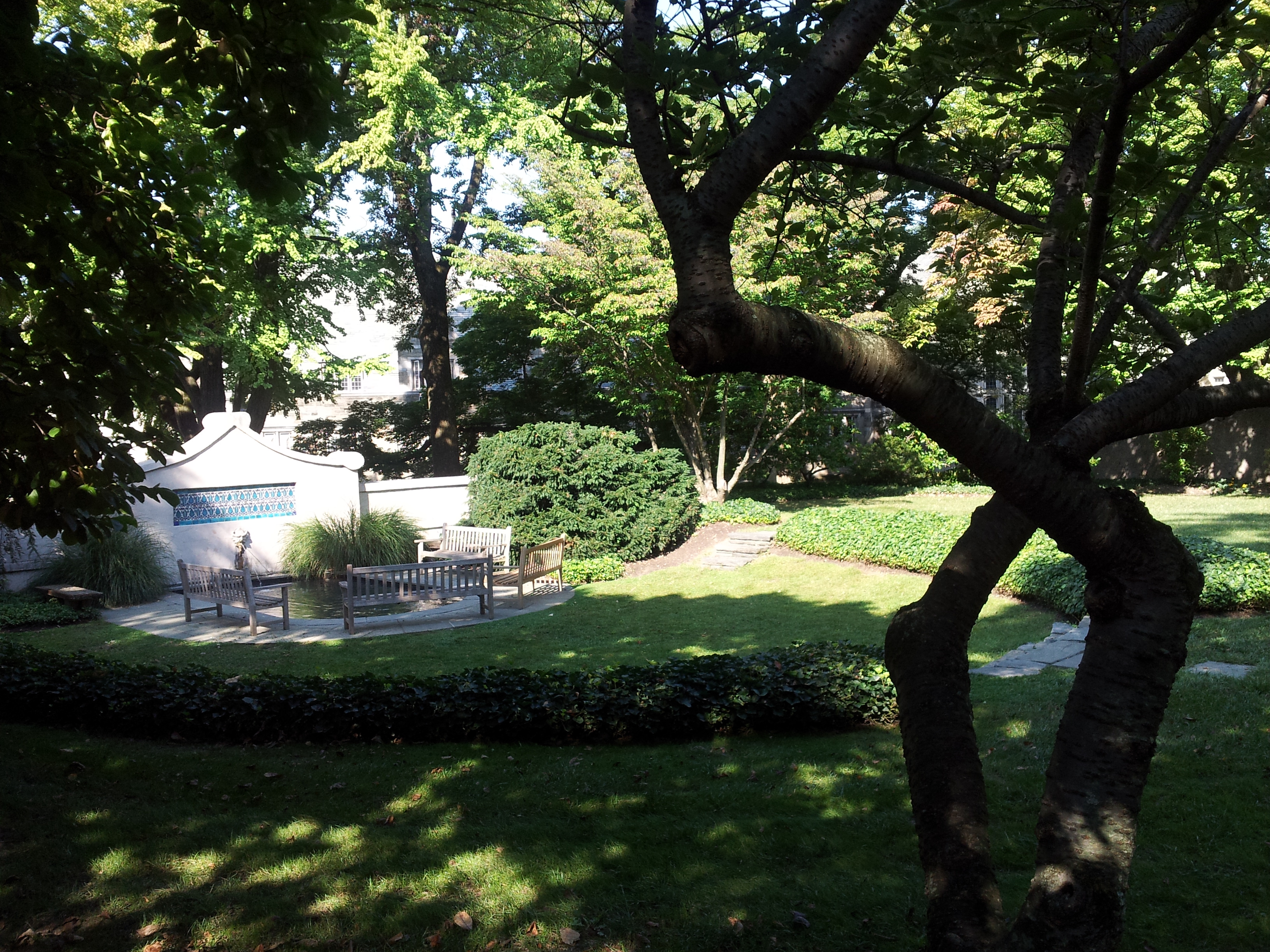
Meditative Moments
"We do not see things as they are, but as we are" - Anais Nin

A Room with a View
“We cast a shadow on something wherever we stand, and it is no good moving from place to place to save things; because the shadow always follows. Choose a place where you won't do harm - yes, choose a place where you won't do very much harm, and stand in it for all you are worth, facing the sunshine.”
- E. M Forster, A Room with a View

NASA Space Colony Artwork 1970s
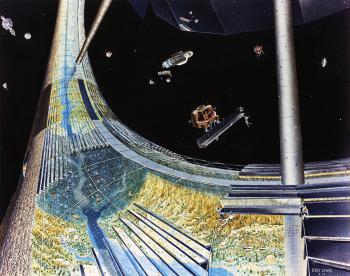
So. In my google search for images of the campus, I found this site. These images don't represent the campus for me (though I did make the "Bryn Mawr Bubble" connection while I was looking at the Toroidial colony), so this post is just for fun.
I love that NASA validated this dream-world. I did a little more searching and found out that NASA hosts this contest every year -

Centering Across Time
SourceURL:file://localhost/Users/naninevalen/Desktop/Ecology/Centered%20Across%20Time.doc
Late Spring, 1970 /Late Summer, 2012
What makes a place feel like a center of the campus? Is it a physical center or an emotional or psychological center? Is it a place where something happened? Something good? Or a place that holds a disturbing memory of some kind? How, or where, can we approach our mind’s psychic centers and edges through the confines of physical space?
I was a sophomore at Bryn Mawr in 1970, 42 years ago. Yet now as I wander around, I discover I am drawn toward several places in particular – two are near the campus’s physical center. Taylor’s high tower marks a center of campus. All the “English” literature and most language classes were once held here.
West Philly Meander
It does not seem like there is a point in my day in which I go on a “proper” Thoreauvian walk; in fact, it does not seem that many places around me offer the possibility of walking without guided action. It was thus hard to imagine a free-roaming meander, a saunter, a true meditative exploration on the outskirts of University City. After all, every step you took has you along another path that someone has created specifically to lead you to McDondalds or Chipotle or the UPenn Library; down Locust Walk, where it is almost permissible to saunter, bikes zoom past you while sorority girls and frat boys drunkenly bop shoulders and shrill like windchimes. Between destinations your head needs to be up and perceptive; they key in this sentence is the assurance that one must always have a destination while walking; an aimless amble could put you in danger and lead you into the wrong type of situation.

Turning in Circles
Nature is a world onto itself, but like anything it is impossible to observe impartially. It always needs a lens through which to be seen, and on this clear September morning, that lens was me. I wish that I could say that I walked out of my dorm and was immediately struck by the beauty of the natural landscape; by the morning dew, and the robins with nest twigs, or the damp moss and the squishy mud. I did notice those things. Just not initially. I first had to learn to look for them. My first thoughts were along the lines of, “okay I’m outside walking. NOW what?” Then, as I strolled through Bryn Mawr’s campus, something interesting began to happen. I didn’t think so much about the natural world, nestled up against the old, man-made buildings, but I thought about my experiences in the place. I remembered deep conversations held in the grass outside of an archway, and sunny afternoons spent on a blanket getting sunburned. My experience of walking was more about my memories staged throughout the campus, rather than looking at the campus itself. However, the more I walked, the easier it got to simply be present in the moment and observe what was around me rather than jumping back into past experiences. I began to take note of the foliage and the stiff air and the chunks of quartz scattered on the ground.

Blissfully Ignorant Wanderings
As I was about to begin my Thoreauvian walk around the Bryn Mawr campus, I considered briefly examining a map of the campus so I could get a better sense of where my walk might take me. But as I considered whether or not to do so, I thought back to how Thoreau described the Saunterers of the Middle Ages. Thoreau describes the Saunterers as wanderers whose intentions were to reach the Holy Land but were not bound to the final goal of reaching the Holy Land and rove and idly take their time in doing so. Unlike, the Saunterers I was not trying to get to one particular destination but like them I was perfectly content with wandering, soaking in the campus landscape and taking my time in doing so. Examining a map, I concluded, would conflict with the point of this walk because doing so would give a set idea of what I could expect on this walk of campus, rather than letting my own sauntering and exploration give me a sense of what the Bryn Mawr campus had to offer me. As a Haverford student, with the exceptions of the dining halls, and the locations of various classes and events I attended, I wasn’t as familiar with the campus as a Bryn Mawr student or faculty member who knew exactly what the campus had to offer. But because I had little knowledge of the campus, I had what Thoreau described as “useful ignorance”, in the sense that because I had no extensive knowledge of the majority of the campus and thus everything that I came across would seem new and fresh.
Blurred Boundaries
I’ve never been very good at wandering or walking without any sort of plan. Hence the reason a planned to circle the campus out edges and then explore its inner parts. Of course, like with any sort of plan, it inevitably changed. I began my walk after brunch, around noontime, heading down Erdman Driveway. In this part of campus, the boundaries were very clear, usually marked by sidewalks or beautifully trimmed bushes. After deciding that these boundaries were easily identified, I turned my attention toward my surroundings, marveling at the clear sky with perfect clouds and reading license plates. Eventually my gaze fell upon this little white house right beside the Admissions parking lot. Here began my true saunter and my plan began to fade away. I was able to identify the building as the site of Human Resources and continued through the parking lot to take a look at the next never-before-seen sight. After learning that the gate to Admissions was adorned with lanterns given to the college by the Alumnae Association to celebrate past, present and future Mawrters, I turned the corner onto Yarrow Street and was met with a yet another gateway that presented me with a little bit of a conundrum.

A Guided Saunter
In order to walk through Bryn Mawr like Thoreau, I began at the center. I felt that as locating the center was an objective of mine, I could not let a predetermined destination interfere with the way nature wanted to take me. Nature was guiding me. Nothing else should be guiding me. Following Thoreau, I wanted to be guided unconsciously by “nature’s subtle magnetism” rather than by an end point. A walk should have no purpose or destination, so I set out on my sauntering walk to see where the walk took me.

Wandering & wondering
I.
For this walk, I felt restricted in my wanderings. I was uncomfortably aware of the need to reflect rather than simply being in the moment. And when I think, was I "present," in my own proceedings? I have to admit that, no, I was mostly divided. I saw, I felt, I heard, and all the time I wanted to translate this into words. But that act of translation, of recording, seems to ruin the experience, no? Or maybe it just leads to other experiences.
Center of Campus, Center of Life
When Henry David Thoreau wrote in “Walking,” “How womankind, who are confined to the house still more than men, stand it I do not know; but I have ground to suspect that most of them do not STAND it at all,” he must have been referring to Mawrtyrs. We have a keen ability to sit in hard chairs all day, perhaps in their carrels in Canaday or Carpenter or around a table in a classroom, pouring over textbooks or activating Serendip. And this is not always a choice because of the pure rigor of our environment. (Welcome to senior year.) We tend to exercise our minds more than our legs. And often, we our brains are so exhausted that when we do walk, it is the distance from our desks to our beds.
Since today is Sunday, a day free of classes, I decided to take a break from my studies and meander across campus. Bryn Mawr truly is beautiful, especially in the sunshine. All jokes aside, I love talking walks around campus and do it often: to clear my mind, to be freed from the Internet and my vastly growing collection of academic articles, to simply revel in the splendor of greenery on Senior Row, behind Ermdan, or in front of Rhoads. I also enjoy gazing at the bold and beautiful buildings of Bryn Mawr. Thoreau writes, “Then it is that I appreciate the beauty and the glory of architecture, which itself never turns in, but forever stands out and erect, keeping watch over the slumberers.” I can say the same.

Boundaries, Edges, and Centers
I began my journey by walking across Senior Row, and stepping up and over the Moon Bench. Through the course of my walk, I became aware of the difference between Inner and Outer borders. To me, the moon bench is a gateway; it marks the end of the inner campus and the beginning of the outer edges. By going over it, instead of around, I felt as if I had transitioned from walking to sauntering. While I may not have had a set route or destination, I had a purpose. The entire point of the walk was that I didn’t know where I was going, because I had never been there before. I had never explored the physical boundaries of Bryn Mawr, and had absolutely no idea what I would find, or even where they were. But had I known, I would have no reason to go there. The entire point of exploration is to see what is to be discovered, regardless of whom else has seen it before. I could now call myself a saunterer in the Thoreauvian sense- I had a purpose, a mental destination. My trek transformed from one of complete aimlessness to one with a point. Had I known where I was going, that point would be mute.



